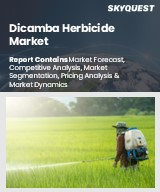
디캄바 제초제 세계 시장 규모는 2023년 5억 3,020만 달러, 2024년 5억 6,625만 달러에서 2032년에는 9억 5,848만 달러에 이르고, 예측 기간(2025-2032년) CAGR은 6.8%를 나타낼 전망입니다.
세계 디캄바 제초제 시장은 식품 수요 증가, 글리포세이트 내성 잡초의 확산, 저휘발성 제제의 발전, 유리한 규제로 인해 크게 성장하고 있습니다. 디캄바는 효과적인 잡초 방제 솔루션으로 작용하며, 농부들은 잡초와의 경쟁을 줄여 작물의 생산성을 높일 수 있습니다. 주요 생명공학 기업들이 디캄바 내성 종자 품종을 개발하면서 제초제의 광범위한 채택을 촉진하고 있습니다. 또한, 혁신적인 기술은 디캄바의 환경적 적합성과 법적 수용성을 강화하여 규제적 도전에도 불구하고 디캄바의 지속적인 관련성을 보장하고 있으며, AI, 머신러닝, IoT, 블록체인의 통합은 작업 효율성, 정확성, 규정 준수를 최적화하여 디캄바 살포에 혁명을 일으키고 있습니다. 궁극적으로 농가의 신뢰를 높이고 이 분야 시장 성장을 가속하고 있습니다.
Global Dicamba herbicide Market size was valued at USD 530.2 million in 2023 and is poised to grow from USD 566.25 million in 2024 to USD 958.48 million by 2032, growing at a CAGR of 6.8% during the forecast period (2025-2032).
The global dicamba herbicide market is experiencing significant growth driven by the increasing demand for food, the prevalence of glyphosate-resistant weeds, advancements in low-volatility formulations, and favorable regulations. Dicamba serves as an effective weed control solution, enabling farmers to enhance crop productivity by reducing weed competition. The development of dicamba-tolerant seed varieties by major biotechnology companies is facilitating wider adoption of the herbicide. Additionally, innovative technologies are enhancing both environmental compatibility and legal acceptance of dicamba, ensuring its continued relevance amidst regulatory challenges. The integration of AI, machine learning, IoT, and blockchain is revolutionizing dicamba application by optimizing operational efficiency, precision, and compliance, ultimately bolstering farmer confidence and driving market growth in the sector.
Top-down and bottom-up approaches were used to estimate and validate the size of the Global Dicamba herbicide market and to estimate the size of various other dependent submarkets. The research methodology used to estimate the market size includes the following details: The key players in the market were identified through secondary research, and their market shares in the respective regions were determined through primary and secondary research. This entire procedure includes the study of the annual and financial reports of the top market players and extensive interviews for key insights from industry leaders such as CEOs, VPs, directors, and marketing executives. All percentage shares split, and breakdowns were determined using secondary sources and verified through Primary sources. All possible parameters that affect the markets covered in this research study have been accounted for, viewed in extensive detail, verified through primary research, and analyzed to get the final quantitative and qualitative data.
Global Dicamba herbicide Market Segments Analysis
Global Dicamba herbicide Market is segmented by Physical Form, Time of Application, Crop Type, Formulation and region. Based on Physical Form, the market is segmented into Liquid and Dry. Based on Time of Application, the market is segmented into Post-Emergence and Pre-Emergence. Based on Crop Type, the market is segmented into Cereals & Grains, Oilseeds & Pulses and Pastures & Forage Crops. Based on Formulation, the market is segmented into Salt and Acid. Based on region, the market is segmented into North America, Europe, Asia Pacific, Latin America and Middle East & Africa.
Driver of the Global Dicamba herbicide Market
The global Dicamba herbicide market is driven by the increasing need for effective weed management in food grain production, which is crucial for meeting the rising food demand stemming from population growth. Farmers are increasingly utilizing Dicamba to achieve higher yields and protect their crops from broadleaf weeds, thus enhancing overall agricultural productivity. As the focus on maximizing grain production intensifies, the necessity for reliable and broad-spectrum weed control solutions, such as Dicamba, is expected to surge. This trend reflects the ongoing commitment of the agricultural sector to ensure food security through advanced herbicide options.
Restraints in the Global Dicamba herbicide Market
The global Dicamba herbicide market faces significant challenges due to the volatility of the chemical, which can vaporize following application and drift into adjacent fields, causing harm to non-resistant crops, sensitive plants, orchards, and vineyards. This tendency for drift has led to previous bans in various regions and numerous lawsuits against its application. Despite advancements made by companies to create formulations that minimize drift, the reality is that these innovations sometimes result in increased application rates by farmers, leading to unintended consequences and further complicating the herbicide's market presence.
Market Trends of the Global Dicamba herbicide Market
The Global Dicamba Herbicide Market is experiencing a significant trend driven by the escalating issue of weed resistance, particularly against glyphosate-tolerant species such as pigweed and waterhemp. As resistant weed populations continue to proliferate, the demand for dicamba-based solutions has surged, prompting agribusinesses to intensify their research and development efforts. These investments aim to create advanced formulations and integrated herbicide systems that enhance efficacy and promote sustainable agricultural practices. This trend is notably crucial in soybean and cotton sectors, where resistance challenges are most pronounced, ensuring that crop yields are maintained while addressing the pressing need for effective weed management strategies.